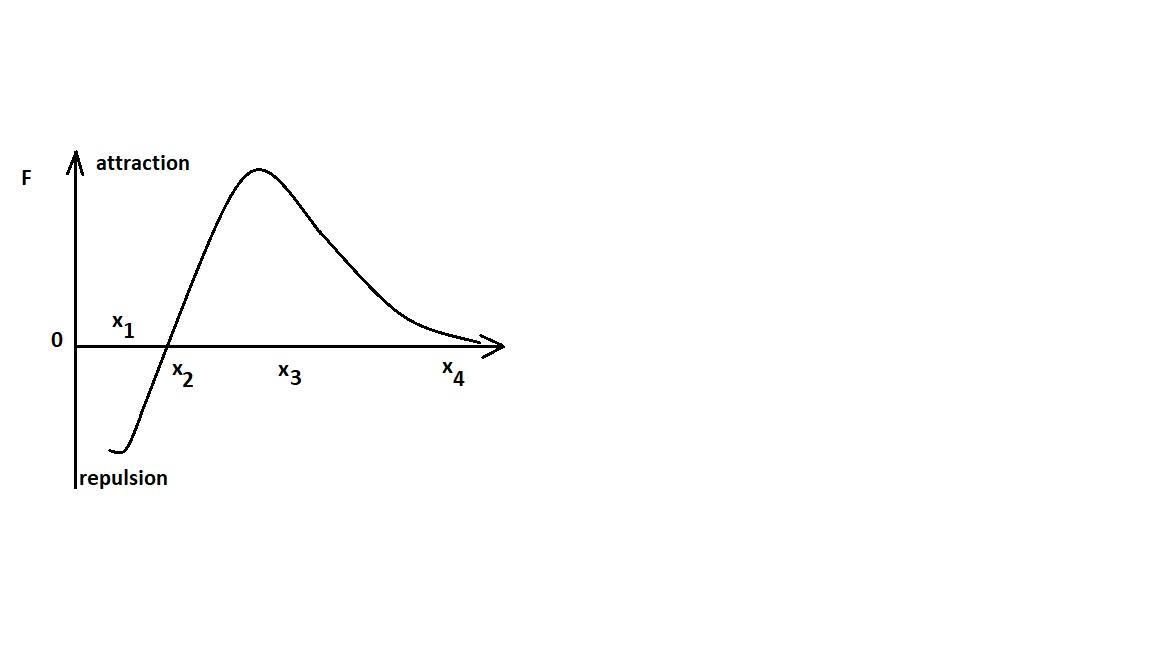
The diagram given shows how the net interaction force (conservative) between two particles $A$ and $B$ is related to the distance between them varies from \[{x_1}\] to \[{x_2}\] . Then
(A) Potential energy of the system increases from \[{x_1}\] to \[{x_2}\]
(B) Potential energy of the system increases from \[{x_2}\] to \[{x_3}\]
(C) Potential energy of the system increases from \[{x_3}\] to \[{x_4}\]
(D) KE increases from \[{x_1}\] to \[{x_2}\] and decreases from \[{x_2}\] to \[{x_3}\]

Answer
123k+ views
Hint: We will pull in the concept of potential energy to be the work done stored by the system. We will then try out the relationships and then finally find the correct option.
Formulae Used $F = - \frac{{dU}}{{dx}}$
Step By Step Solution
Firstly,
$F = - \frac{{dU}}{{dx}}$
Thus, we can say,
\[dU = - Fdx\]
Now,
Clearly,
When $F$ is positive, $dU$ is negative and when $F$ is negative, $dU$ is positive.
For the region from \[{x_1}\] to \[{x_2}\] , $F$ is negative as we can see from the graph itself.
Thus, $dU$ is positive.
Which means potential energy increases from \[{x_1}\] to \[{x_2}\].
Now,
Again for the region \[{x_2}\] to \[{x_3}\], $F$ is positive.
Thus, we can say $dU$ is negative.
Which means that potential energy decreases from \[{x_2}\] to \[{x_3}\].
Now,
For the region \[{x_3}\] to \[{x_4}\] , the force keeps on decreasing making it negative.
Thus,
$F$ is negative here.
Thus,
\[dU\] is positive.
Which means potential energy increases here.
Thus, taking all these observations into consideration, we can say (A) is the correct option.
Note: When $dU$ is positive, the potential energy increases because $dU$ refers to the change in the potential energy. When its value is positive, the final potential energy value is greater than the initial potential energy value. Thus making its overall value to be positive. The same analogy goes true when $dU$ is negative.
Formulae Used $F = - \frac{{dU}}{{dx}}$
Step By Step Solution
Firstly,
$F = - \frac{{dU}}{{dx}}$
Thus, we can say,
\[dU = - Fdx\]
Now,
Clearly,
When $F$ is positive, $dU$ is negative and when $F$ is negative, $dU$ is positive.
For the region from \[{x_1}\] to \[{x_2}\] , $F$ is negative as we can see from the graph itself.
Thus, $dU$ is positive.
Which means potential energy increases from \[{x_1}\] to \[{x_2}\].
Now,
Again for the region \[{x_2}\] to \[{x_3}\], $F$ is positive.
Thus, we can say $dU$ is negative.
Which means that potential energy decreases from \[{x_2}\] to \[{x_3}\].
Now,
For the region \[{x_3}\] to \[{x_4}\] , the force keeps on decreasing making it negative.
Thus,
$F$ is negative here.
Thus,
\[dU\] is positive.
Which means potential energy increases here.
Thus, taking all these observations into consideration, we can say (A) is the correct option.
Note: When $dU$ is positive, the potential energy increases because $dU$ refers to the change in the potential energy. When its value is positive, the final potential energy value is greater than the initial potential energy value. Thus making its overall value to be positive. The same analogy goes true when $dU$ is negative.
Recently Updated Pages
The ratio of the diameters of two metallic rods of class 11 physics JEE_Main

What is the difference between Conduction and conv class 11 physics JEE_Main

Mark the correct statements about the friction between class 11 physics JEE_Main

Find the acceleration of the wedge towards the right class 11 physics JEE_Main

A standing wave is formed by the superposition of two class 11 physics JEE_Main

Derive an expression for work done by the gas in an class 11 physics JEE_Main

Trending doubts
JEE Main 2025 Session 2: Application Form (Out), Exam Dates (Released), Eligibility & More

JEE Main Login 2045: Step-by-Step Instructions and Details

Class 11 JEE Main Physics Mock Test 2025

JEE Main Exam Marking Scheme: Detailed Breakdown of Marks and Negative Marking

JEE Main 2023 January 24 Shift 2 Question Paper with Answer Keys & Solutions

JEE Main 2025: Conversion of Galvanometer Into Ammeter And Voltmeter in Physics

Other Pages
JEE Advanced Marks vs Ranks 2025: Understanding Category-wise Qualifying Marks and Previous Year Cut-offs

NCERT Solutions for Class 11 Physics Chapter 1 Units and Measurements

NCERT Solutions for Class 11 Physics Chapter 9 Mechanical Properties of Fluids

Units and Measurements Class 11 Notes: CBSE Physics Chapter 1

JEE Advanced 2025: Dates, Registration, Syllabus, Eligibility Criteria and More

NCERT Solutions for Class 11 Physics Chapter 2 Motion In A Straight Line




